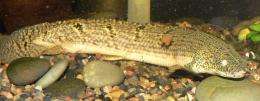Photo of Polypterus weeksii (mottled bichir). Image: Wikipedia.
(PhysOrg.com) -- History has shown that many invertebrates are able to regenerate lost limbs. Rare however, are animals with backbones that are able to do so, and when they do exist, they are usually amphibians or a few species of fish that regenerate parts that are mostly made of skin-like material. Thus the discovery of two species of Polypterus bichir, fish found in Africa, that can regenerate a lost side (pectoral) fin in as little as a month has created some excitement in the scientific community. Such fish are ray-finned, which means their fins are made up of skin-like webbing stretched between bony structures connected directly to the skeleton. Rodrigo Cuervo, a biologist with Veracruz University in Mexico discovered the fish’s unique abilities and has co-written a paper about them with colleagues. They have published the results of their findings in the Proceedings of the National Academy of Sciences.
In addition to being a unique find, the discovery suggests that those early fish a long time ago who first hoisted themselves up on land, likely also had such an ability. This is because bichir share traits with both modern amphibians and ancient four-limbed creatures that are known to have walked on land.
Scientists don’t know why some animals can regenerate body parts, while others such as humans cannot; they’d really like to of course, because it might lead to a way to cause it to happen when it’s needed. What’s exciting about the bichir discovery is that it means regeneration of limbs that contain real bone is possible and by studying them, researchers might be able to figure out how it is made to happen.
Also of interest is how accurate the newly regenerated fins were found to be. Many regenerations are not. In humans for example, when skin is regenerated, it quite often remains noticeable due to the differences between normal skin and scar tissue. The same thing happens when bones are broken and then mend. With the bichir fins, the researchers found that the new ones were almost perfect reproductions of the ones they’d lost. They also found that the fish can also regenerate their tails if lost, though this feature is not nearly as remarkable as the tail doesn’t have bones that are connected to the skeleton.
More information: Full regeneration of the tribasal Polypterus fin, PNAS, Published online before print February 21, 2012, doi: 10.1073/pnas.1006619109
Abstract
Full limb regeneration is a property that seems to be restricted to urodele amphibians. Here we found that Polypterus, the most basal living ray-finned fish, regenerates its pectoral lobed fins with a remarkable accuracy. Pectoral Polypterus fins are complex, formed by a well-organized endoskeleton to which the exoskeleton rays are connected. Regeneration initiates with the formation of a blastema similar to that observed in regenerating amphibian limbs. Retinoic acid induces dose-dependent phenotypes ranging from inhibition of regeneration to apparent anterior–posterior duplications. As in all developing tetrapod limbs and regenerating amphibian blastema, Sonic hedgehog is expressed in the posterior mesenchyme during fin regeneration. Hedgehog signaling plays a role in the regeneration and patterning processes: an increase or reduction of fin bony elements results when this signaling is activated or disrupted, respectively. The tail fin also regenerates but, in contrast with pectoral fins, regeneration can resume after release from the arrest caused by hedgehog inhibition. A comparative analysis of fin phenotypes obtained after retinoic acid treatment or altering the hedgehog signaling levels during regeneration allowed us to assign a limb tetrapod equivalent segment to Polypterus fin skeletal structures, thus providing clues to the origin of the autopod. We propose that appendage regeneration was a common property of vertebrates during the fin to limb transition.
via ScienceNews
Journal information: Proceedings of the National Academy of Sciences
© 2011 PhysOrg.com





















